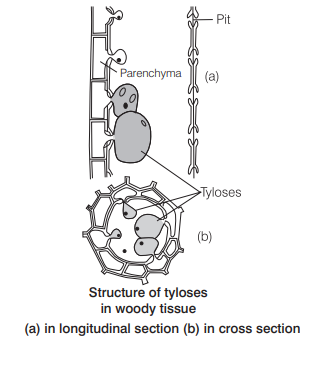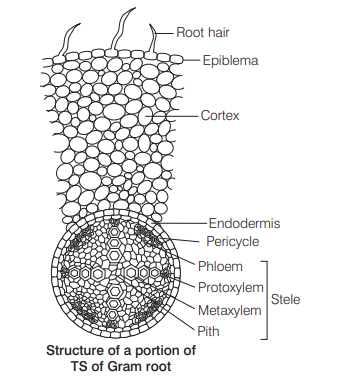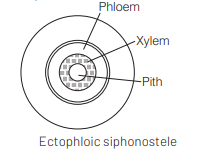Question
In dicot root, the vascular cambium originates from [NEET (Odisha) 2019]
(a) tissue located below the phloem bundles and a portion of pericycle tissue above protoxylem
(b) cortical region
(c) parenchyma between endodermis and pericycle
(d) intrafascicular and interfascicular tissue in a ring
Answer/Explanation
Ans. (a)
In dicot root, the vascular cambium originates from tissues located below the phloem bundles and a portion of pericycle tissue above protoxylem.
Vascular cambium is the meristematic layer that is responsible for cutting off vascular tissues (xylem and philvem). In young stem, it is present in patches as a single layer between the xylem and phloem.
Question
Casparian strips occur in [NEET 2018]
(a) cortex
(b) pericycle
(c) epidermis
(d) endodermis
Answer/Explanation
Ans. (d)
Casparian strips are found in endodermis of roots. It is a band of thickening which runs along the radial and tangential walls of endodermal cells. It is made up of suberin and lignin. Casparian strips prevent plasmolysis of endodermal cells.
Cortex is found below epiblema. It is made up of thin-walled parenchymal cells. Epidermis is the outermost layer made up of thin-walled flattened and slightly elongated parenchymal cells. Pericycle is found below endodermis and it is made of parenchymatous cells.
Question
The balloon-shaped structures called tyloses [NEET 2016, Phase II]
(a) originate in the lumen of vessels
(b) characterise the sapwood
(c) are extensions of xylem parenchyma cells into vessels
(d) are linked to the ascent of sap through xylem vessels
Answer/Explanation
Ans. (c)
The tyloses are the structures found in the woody tissues of dicot stems. These are the extensions of xylem parenchyma cells into the vessel elements.

Question
Cortex is the region found between [NEET 2016, Phase II]
(a) epidermis and stele
(b) pericycle and endodermis
(c) endodermis and pith
(d) endodermis and vascular bundle
Answer/Explanation
Ans. (a)
Cortex tissue is found in between the epidermis and stele. It is multilayered and is made up of parenchymatous cells with big intercellular spaces.

Question
Anatomically fairly old dicotyledonous root is distinguished from the dicotyledonous stem by [CBSE AIPMT 2009]
(a) absence of secondary xylem
(b) absence of secondary phloem
(c) presence of cortex
(d) position of protoxylem
Answer/Explanation
Ans. (d)
In dicotyledonous root, the condition of xylem is exarch as the protoxylem is away from the centre and metaxylem is towards the centre. In dicotyledonous stem, (e.g. Cucurbita), the condition of xylem is endarch as the metaxylem is away from the centre and protoxylem is towards the centre.
Question
In a woody dicotyledonous tree which of the following parts will mainly consist of primary tissues? [CBSE AIPMT 2005]
(a) All parts
(b) Stem and root
(c) Flowers, fruits and leaves
(d) Shoot tips and root tips
Answer/Explanation
Ans. (d)
Primary tissues are those meristematic tissues which are derived directly from embryonal tissues.
e.g. shoot apex and root apex.
Question
Ectophloic siphonostele is found in [CBSE AIPMT 2005]
(a) Adiantum and Cucurbitaceae
(b) Osmunda and Equisetum
(c) Marsileo and Botrychium
(d) Dicksonia and maiden hair fern
Answer/Explanation
Ans. (b)
In the ectophloic siphonostele, the xylem surrounds pith and this xylem is surrounded by phloem, pericycle and endodermis respectively. e.g. Osmunda and Equisetum.
Question
In a longitudinal section of root, starting from the tip upward, the four zones occur in the following order [CBSE AIPMT 2004]
(a) root cap, cell division, cell enlargement, cell maturation
(b) root cap, cell division, cell maturation, cell enlargement
(c) cell division, cell enlargement, cell maturation, root cap
(d) cell division, cell maturation, cell enlargement, root cap
Answer/Explanation
Ans. (a)
In a longitudinal section of root, starting from the tip upward the four zones occur in the following order
Root cap $\rightarrow$ Zone of cell division $\rightarrow$ Zone of cell enlargement $\rightarrow$ Zone of cell maturation
Question
Pericycle of roots produces [CBSE AIPMT 1990]
(a) mechanical support
(b) lateral roots
(c) vascular bundles
(d) adventitious buds
Answer/Explanation
Ans. (b)
In roots, pericycle lies below endodermis and is made of one or more layers of parenchymatous cells. Pericycle gives rise to lateral roots, root branches of vascular cambium and whole of cork cambium.
Question
Where do the casparian bands occur? [CBSE AIPMT 1990, 94, 99]
(a) Epidermis
(b) Endodermis
(c) Pericycle
(d) Phloem
Answer/Explanation
Ans. (b)
In roots, the inner most layer of cortex, i.e. endodermis consists of compactly arranged barrel shaped cells that possess ligno-suberin thickenings called casparian strips. In dicot stems, endodermis is called starch sheath, it does not contain casparian strips.
Question
A bicollateral vascular bundle is characterised by [CBSE AIPMT 1992]
(a) phloem being sandwitched between xylem
(b) transverse splitting of vascular bundle
(c) longitudinal splitting of vascular bundle
(d) xylem being sandwitched between phloem
Answer/Explanation
Ans. (d)
Bicollateral vascular bundles are conjoint bundles having phloem both on the outer and inner side of xylem, e.g. Cucurbita. These vascular bundle generally seen in Solanaceae (the potato family) and cucurbitaceae (the cucumber family). In this situation phloem is present on both outside and inside the xylem.
